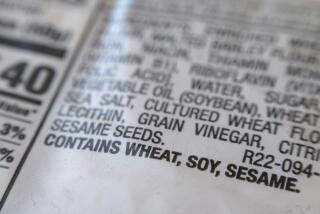Editorial: The FDA’s problematic push for an added-sugar label on food
- Share via
Sugar has been identified as the new dietary demon, taking on the role from once-vilified fats, and it probably deserves much of that reputation. Research has piled up on sugar’s role in adding calories without nutrition, and on spiking and dropping blood-sugar levels that can result in cravings for more food.
Even so, it’s hard to fully understand the reasoning behind the new push by the U.S. Food and Drug Administration to label “added sugars”—those that don’t exist naturally in the food. It might usefully make shoppers more aware of just how often sugar is added to foods that aren’t associated with sweetness—canned soups or deli turkey. But isn’t the overall issue how much sugar is in there, rather than how much is added?
This is a theme that comes up time and again in the discussion about soda, in which all the sugars are “added.” But that doesn’t make apple juice—which has as many sugar calories as soda, without appreciably more nutrition—much better for you. (Another aspect that research is finding important is whether the sugar is in a whole food. The sugars in an apple appear to be digested more slowly than those in juice.)
Which also begs the question of how the FDA will define added sugars. Some jams proudly announce that they have “no added sugar” but are upping the sweetness level with grape-juice concentrate. That concentrate is high in sugar, but will it count as added sugar under the new labeling requirement? What about if it’s added to other processed foods as well?
Another issue: Many nutritionists think that highly processed grains—think white flour—have pretty much the same nutritional profile as sugar. Same blood-sugar spiking, calories added with little nutrition. It might not make sense to label one and not the other.
There’s already a fair amount of labeling on sugars. In all their forms, they must be listed among the ingredients. One way that companies tend to hide their use of sugar, though, is to use several different ones. That means other ingredients will be listed first, because they make up a higher percentage of the weight, even though the total sugar might be high.
But the nutrition label already tells how much sugar is in the food—added and not. Eating a very high-sugar diet, whether that occurs naturally in the food or not, could end up being problematic. There’s value to seeing just how much of our food is doctored with sugars to make it more palatable. The labels, and consumer reaction to them, might push food companies into producing more wholesome food—or they might simply add sugar in the form of juice concentrates. Who’s to say that grape juice concentrate isn’t a natural ingredient of tomato soup?
Follow the Opinion section on Twitter @latimesopinion and Facebook
More to Read
A cure for the common opinion
Get thought-provoking perspectives with our weekly newsletter.
You may occasionally receive promotional content from the Los Angeles Times.







